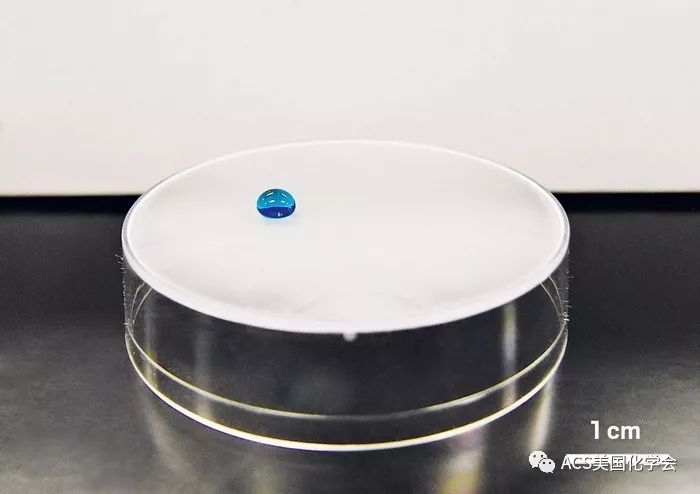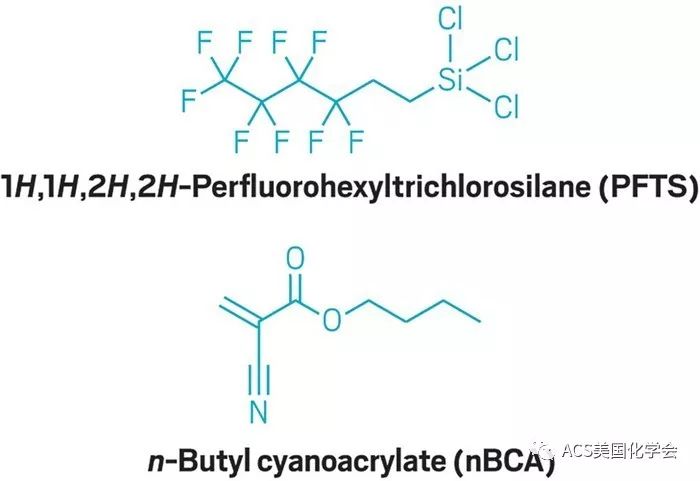Fluorinated coating is utterly repellent
by Mark Peplow, special to C&EN
一种全透明的、有自愈能力的薄镀层可以抵御包含浓酸与低界面张力有机溶剂以内的一百多种液态的腐蚀

The new fluorinated coating protects a polystyrene petri dish from a droplet of the solvent tetrahydrofuran (colored blue). The solvent normally dissolves this plastic.
Credit: Nat. Mater.
有一些防潮镀层泡浸在水里时仍可以维持干躁,也有一些镀层可以阻隔油及其有机溶液。也有一些镀层则可以承受严苛的自然环境,可解决强碱及高溫,乃至在被损坏后可以自己变好。
现如今,科学研究工作人员造就了安全防护镀层行业当之无愧的瑞士军刀。因为其特有的有机化学特性和材质,这类镀层在融合了以上提及的全部特性以外,还具备别的的特性(Nat.Mater。2018,DOI:10.1038/ s41563-018-0178-2)。“大家操纵一系列不一样的构造,从离子键到外部经济水准的纳米技术构造。”墨尔本大学的唐纳德卡鲁索(Frank Caruso)讲到。他是这一超级全能原材料研发部门的科学研究工作人员之一。
上边提及的镀层是一种包括了1H,1H,2H,2H-全氟己基三氯硅烷(PFTS)和磺酸基丙烯酸正丁酯(n-BCA)的混合物质,在二氯五氟丁烷饱和溶液中混和。当其被喷漆于表层时,空气中的水蒸汽会引起PFTS和n-BCA中间的一系列缩聚反应,产生坚毅、全透明的塑料薄膜。该塑料薄膜镀层带有高聚物金纳米颗粒,汇聚合拼产生具备优良材质的涂方面,而这种涂方面可以捕获细微的气体产生的汽泡夹层,以具有阻止液态的功效。
在检测中,该涂膜可以隔绝包含水、正戊烷、全氟己烷和浓盐酸以内的100各种不同的液态。出液通常在镀层上产生似球型的水雾,并与图方面产生最少150度的表面张力。有着这类表面张力标值的镀层通常会被觉得具备“超防液性”。稍微偏斜表层– 通常低于5度– 便充足使出液干净利索地从镀层表层滚离。当正戊烷(一种具备极低的界面张力而且会打湿大部分表层的化学物质)被喷入该镀层上边时,镀层表层可以随便地将其弹落。
A jet of pentane bounces right off this stainless steel mesh, thanks to its super-repellent coating. This solvent will wet most surfaces.
Credit: Nat. Mater.
科学研究工作员表明,n-BCA可当做一种强力粘合剂,将以上建筑涂料固定不动在包含木料、金属材料、夹层玻璃和涤纶布纺织物以内的各类原材料上。卡鲁索觉得,这类强粘结力还能够减少镀层肇事逃逸到自然环境中的风险性,而这一问题一直困惑着别的多氟化合物的运用。

该镀层在100℃也可以再次抵触液态,并在刮擦、碾磨和清洗后维持其特性。仅有当科学研究工作人员用氧等离子冲洗它时,该镀层才会丧失其防液性。即使如此,该原材料也可以在遭受以上解决后,在常温下24小时后自己变好,或是在120°C时于10min内修复。换句话说,当该镀层中的高聚物链资产重组时,该镀层会终获其此前全部的超自然能力。

The microscopic structure of the new fluorinated coating may help to create a cushion of air that improves its repellent properties.
Credit: Nat. Mater.
来源于马克斯×海洋之灾高聚物研究室、科学研究非常防液镀层的Doris Vollmer表明,很多以上提及的非常防液特性早已被加入到了之前创造发明出來的资料中。可是这一次的镀层对正戊烷的抵触工作能力是不寻常的,由于该镀层能在自己修补后彻底恢复对正戊烷液态的抵抗性。“这比我见过的别的建筑涂料更强。”她讲。
杜勒姆高校开发设计作用表层材质的Jas Pal S. Badyal说,这类建筑涂料简易的喷漆方式,也可以使其在商业服务运用上更具有诱惑力。“这类一步到位的(喷漆)方式非常好。”他说道。殊不知,应用二氯五氟丁烷做为建筑涂料磷酸激酶的有机溶剂,很有可能变成商业服务宣传中的拦路虎,由于这种卤化对自然环境有不良影响。
A drop of pentane falls onto a piece of fabric with a super-repellent coating.
Credit: Nat. Mater.
Caruso提议,这类原材料最后可以开发设计成用以屏蔽掉有机化学干扰的镀层,而且该人员早已逐渐与工业生产小伙伴协作。“但这些原材料在使用层面仍有较长的路要走。”他填补说,并强调科学研究工作人员必须减少镀层成本费并评定其长期性耐磨性能。
Transparent, self-healing film fends off more than 100 liquids, including concentrated acids and low-surface-tension solvents
Some liquid-repelling coatings stay dry in a deluge of water, while others rebuff oils and organic solvents. Some can withstand harsh treatment, shrugging off harsh acids, high temperatures, or even healing themselves after being damaged.
Now researchers have created a veritable Swiss Army knife of a repellent coating that combines all of these properties and more, thanks to its unique chemistry and texture (Nat. Mater. 2018, DOI: 10.1038/s41563-018-0178-2). “We’re controlling a range of different structures, from the chemical bond to the nanoscale to the microscopic level,” says Frank Caruso of the University of Melbourne, part of the team behind the super-omniphobic material.
The coating is a mixture of 1H,1H,2H,2H-perfluorohexyltrichlorosilane (PFTS) and n-butyl cyanoacrylate (n-BCA), combined in a dichloropentafluoropropane solution. When sprayed onto a surface, water vapor in the atmosphere triggers a series of polymerization reactions between PFTS and n-BCA to create a tough, transparent film. The coating contains polymer nanoparticles that aggregate to form a highly textured surface, which may trap tiny pockets of air to help ward off liquids.
In tests, the coating repelled more than 100 different liquids, including water, n-pentane, perfluorohexane, and concentrated hydrofluoric acid. Droplets of liquid typically formed almost spherical globules on the coating, with contact angles of at least 150 degrees—generally regarded as the mark of a super-repellent surface. Slightly tilting a surface—typically less than 5 degrees—was enough to make the droplets roll off cleanly. A jet of n-pentane, which has a very low surface tension and will wet most surfaces, simply bounced off coated surfaces.
The reserchers say that n-BCA acts as a powerful adhesive to anchor the coating to a wide range of substances, including wood, metal, glass and polyester fabric. Caruso suggests that this strong adhesion may also reduce the risk of the coating escaping into the environment, a problem that has bedeviled other polyfluorinated compounds.
The coating continued to repel liquids at 100 °C and retained its properties after scratching, abrading, and washing. Only when the researchers scoured it with oxygen plasma did it lose its repellency. Even then, the material healed itself after 24 hours at room temperature, or in just 10 minutes if heated to 120 °C, regaining its full complement of super powers as its polymer chains reorganized themselves.
Many of these properties have been combined in previous materials, says Doris Vollmer at the Max Planck Institute for Polymer Research, who studies super-repellent coatings. But the coating’s ability to repel n-pentane is unusual, as is the complete recovery of n-pentane repellency after self-healing. “That is better than I’ve seen with other coatings,” she says.
The simple, spray-on method could also make this coating attractive for commercial applications, says Jas Pal S. Badyal, who develops functional surfaces at Durham University. “The one-step approach is good,” he says. However, using dichloropentafluoropropane as a solvent for the coating’s precursors could be a stumbling block, he adds, due to the environmental impact of such halogenated compounds.
Caruso suggests that the material could eventually be developed into a coating for chemical hazard shielding, and the team is already working with industry partners. “But there’s still a long way to go in terms of applications,” he adds, noting that they need to reduce the cost of the coating and assess its long-term durability.
This article is reproduced with permission from Chemical & Engineering News (© American Chemical Society). The article was first published on OCTOBER 16, 2018 | APPEARED IN VOLUME 96, ISSUE 42.
文章内容来自ACS美国化学会微信公众号,若有侵权行为联络删掉.
 派旗纳米·官方网站
派旗纳米·官方网站
